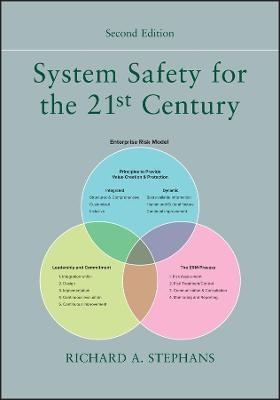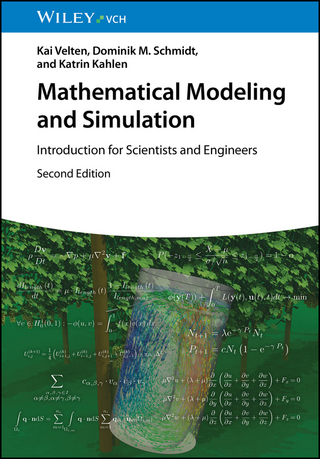
System Safety for the 21st Century
John Wiley & Sons Inc (Verlag)
978-1-119-63475-1 (ISBN)
The Second Edition of System Safety for the 21st Century delivers an authoritative primer on the identification, evaluation, analysis, and control of hazards to people, components, sub-systems, systems, processes, and facilities. The book offers readers a complete discussion on techniques within system safety, the discipline on process safety, as well as a comprehensive treatment on professionalism within the safety industry.
This new edition applies the concepts of system safety to medical disciplines and medical devices, offering readers the potential to have a significantly positive impact on the standing of American medical safety in the world. The latest edition also includes:
A brand-new chapter on the risk management with current international and U.S. government standards
New material on process safety including EPA and OSHA implementation and external reviews
An Instructor Solutions Manual that includes course content and 30 chapters of review questions and answers
Further clarifications on difficult concepts from the First Edition with updated appendices and references
Relevant to academia, industry, and government, System Safety for the 21st Century is an essential resource for anyone studying or implementing and managing proactive hazard identification and risk control techniques and procedures.
Richard A. Stephans semi-retired consultant, former PE, CSP (and Board member of BCSP), CEM, has been an International System Safety Society member for more than thirty years and a Society Fellow, who has served in local and national Society positions, and received several Society awards to include Engineer of the Year. He is coeditor of the System Safety Analysis Handbook, a publication of the International System Safety Society. Stephans is a retired Army Colonel, Paratrooper, Ranger, nuclear weapons specialist, and Vietnam War veteran.
Foreword xiii
Preface xv
Acknowledgments xvii
About The Companion Website xix
Part I Introduction to System Safety 1
1. The History of System Safety 3
The 1960s—Mil-Std-882, DoD, and Nasa 4
The 1970s—The Management Oversight and Risk Tree 4
The 1980s—Facility System Safety 5
The 1990s—Risk-Based Process System Safety 6
The 2000s—Quest for Intrinsic Safety 6
The 2010s—Risk Management Integration 7
The 2020s—Improvements and International Approach to Risk Maturing 7
Review Questions 8
Bibliography 8
2. Fundamentals of System Safety 9
Basic Definitions 9
Fundamental Safety Concepts 9
System Safety Fundamentals 13
System Safety Tenets 18
Review Questions 19
Bibliography 19
3. Current Approaches to System Safety 21
Department of Defense 21
Nasa 26
Facility System Safety 28
The Chemical Industry 31
Department of Energy 32
Review Questions 34
Bibliography 35
4. Problem Areas 37
Standardization 38
Risk Assessment Codes 39
Data 40
Communications 40
Life Cycle 41
Education and Training 41
Human Factors 41
Software 42
Review Questions 42
Bibliography 42
5. The Future of System Safety 43
More First-Time
Safe Systems 43
Cost-Effective Management Tools 43
The Face of System Safety 44
Proactive or Reactive? 47
Review Questions 47
Bibliography 47
Part II System Safety Program Planning and Management 49
6. Establishing the Groundwork 51
Generic Model 51
Product Safety 51
Dual Programs 52
Planning and Development Methodology 52
Review Questions 53
7. Tasks 55
Hazard Identification 56
Hazard Analysis and Control 58
System Safety Support Tasks 60
Review Questions 61
8. System Safety Products 63
System Safety Program Plan 63
Preliminary Hazard List 64
Preliminary Hazard Analysis 66
Hazard Tracking Log 67
Subsystem Hazard Analysis 68
System Hazard Analysis 71
Operating Hazard Analysis 72
Change Analysis Report 73
Accident Analysis Report 74
Review Questions 75
9. Program Implementation 77
Steps 77
Review Questions 88
Table of Contents vii
10. Risk Management 89
Introduction 89
Types of Risk 89
Risk Management 90
Review Questions 96
Bibliography 96
Part Iii Analytical Aids 101
11. Analytical Trees 103
Purposes 104
Tree Construction 105
Fault Trees Versus Fault Tree Analysis 110
Review Questions 115
Bibliography 115
12. Risk Assessment and Risk Acceptance 117
Risk Management Concepts 117
Risk Assessment Shortcomings 123
Total Risk Exposure Codes 124
Review Questions 126
Bibliography 126
13. Human Factors 127
Human Reliability 127
Human Error Rates 129
Improving Human Reliability 130
Human Factors for Engineering Design 132
Review Questions 135
Bibliography 135
Part IV System Safety Analysis Techniques 137
14. Energy Trace and Barrier Analysis 139
Purpose of ETBA 139
Input Requirements 139
General Approach 140
Instructions 140
Review Questions 142
Bibliography 142
15. Failure Mode and Effects Analysis 143
Purpose of FMEA 144
Input Requirements 144
General Approach 144
Instructions 144
Appendix: Sample FMEA 147
Summary 147
Project Description 147
Methodology 149
Review Questions 152
Bibliography 152
16. Fault Tree Analysis 155
Purpose of FTA 155
Input Requirements 156
General Approach 156
Instructions 157
Appendix: Sample FTA 165
Summary 165
Project Description 166
Methodology 167
Review Questions 171
Bibliography 171
17. Project Evaluation Tree 173
Purpose of PET 174
Input Requirements 174
General Approach 174
Instructions 175
Appendix: PET User’s Guide 179
Review Questions 188
Bibliography 188
18. Change Analysis 189
Purpose 189
Input Requirements 190
General Approach 190
Instructions 190
Review Questions 193
Bibliography 193
19. Management Oversight and Risk Tree 195
Purpose of Mort and Mini-Mort 197
Input Requirements 198
General Approach 198
Instructions 205
Review Questions 221
Bibliography 221
20. Event and Causal Factors Charts 223
Purpose 223
Input Requirements 223
General Approach 224
Instructions 224
Review Questions 228
Bibliography 228
21. Other Analytical Techniques 229
Software Hazard Analysis 229
Common Cause Failure Analysis 229
Sneak Circuit Analysis 230
Extreme Value Projection 231
Time-Loss
Analysis 235
Additional Techniques 237
Review Questions 238
Bibliography 238
Part V Process Safety 241
22. Process Safety Management 243
Introduction 243
Background 243
Future 248
Summary 249
Review Questions 249
Bibliography 249
Appendix: List of Highly Hazardous Chemicals, Toxics and Reactives 250
23. EPA’s Equivalent Process Safety Requirements—Risk Management Program (RMP) 255
Background 255
Overall Risk Management Program 255
Summary 259
Review Questions 260
Bibliography 260
Appendix: Substances Listed Under 40 CFR 68 261
24. Process Safety Implementation 263
Introduction 263
PSM Implementation 263
RMP Implementation 270
Implementation Lessons 271
Summary 272
Review Questions 272
Bibliography 273
25. Process Safety Reviews 275
Introduction 275
Mechanics of an Individual Audit 277
Lessons 279
Summary 281
Review Questions 281
Bibliography 281
Part VI System Safety Applied To The Medical Field 283
26. Medical Devices and Equipment 285
Introduction 285
Purpose 285
System Safety Review 285
System Safety Application to Medical Devices 286
System Safety Interface with Medical Devices 288
Considerations for Improvement 289
Conclusions 291
Review Questions 292
Bibliography 292
Appendix 293
27. Infection Control 295
Introduction 295
The Problem 296
What’s Being Done 296
System Safety Considerations 298
Further Improvements 298
System Safety Application 301
Cronavirus 303
Review Questions 304
Bibliography 305
28. Hospitals 307
Introduction 307
Challenges Faced 308
System Safety Application 312
Case Study Hypothetical System Safety Application to a Hospital 315
Anticipating the Future 318
Review Questions 319
Bibliography 319
29. Future Considerations 321
Introduction 321
Definitions 321
Health Care Future Discussion Areas 322
Research and Development 326
System Safety Application to Medical Care in the Future 327
Other Thoughts 329
Conclusions 330
Review Questions 331
Bibliography 331
Part VII Professionalism and Professional Development 333
30. Professionalism and Professional Development 335
Introduction 335
What is Professionalism? 335
Professional Development 337
Accreditation of Certifications 337
Why Become Certified? 339
Summary 341
Review Questions 342
Bibliography 342
Appendices 343
Appendix I: The Scope and Functions of the Professional Safety Position 343
Appendix II: International System Safety Society Fundamental Principles and Canons 347
Appendix III: Professional System Safety and Related Societies and Organizations 351
Glossary 357
Acronyms 365
Bibliography 369
Further Reading 373
About The Author 375
Book Contributor 377
Book Back Cover 379
Index 381
| Erscheinungsdatum | 02.09.2022 |
|---|---|
| Verlagsort | New York |
| Sprache | englisch |
| Maße | 183 x 254 mm |
| Gewicht | 998 g |
| Themenwelt | Naturwissenschaften ► Chemie |
| Technik ► Elektrotechnik / Energietechnik | |
| ISBN-10 | 1-119-63475-X / 111963475X |
| ISBN-13 | 978-1-119-63475-1 / 9781119634751 |
| Zustand | Neuware |
| Informationen gemäß Produktsicherheitsverordnung (GPSR) | |
| Haben Sie eine Frage zum Produkt? |
aus dem Bereich


